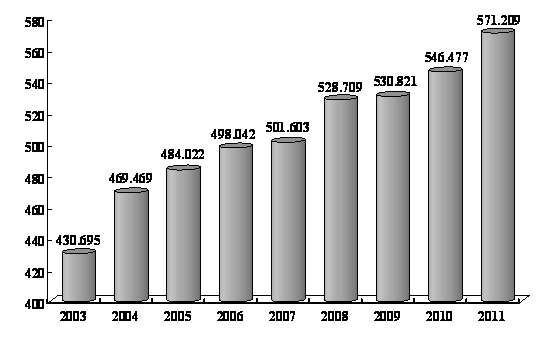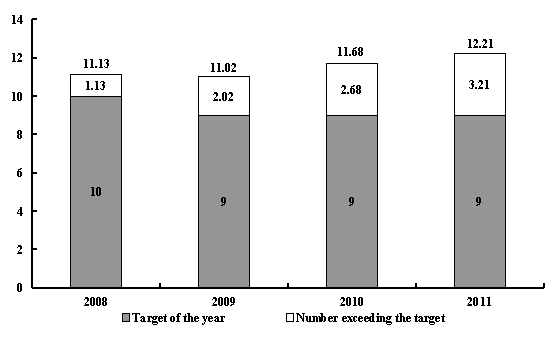Full Text: Report on China's Economic and Social Development Plan
 0 Comment(s)
0 Comment(s) Print
Print E-mail China.org.cn, March 14, 2012
E-mail China.org.cn, March 14, 2012
REPORT ON THE IMPLEMENTATION OF THE 2011 PLAN FOR NATIONAL ECONOMIC AND SOCIAL DEVELOPMENT AND ON THE 2012 DRAFT PLAN FOR NATIONAL ECONOMIC AND SOCIAL DEVELOPMENT
Fifth Session of the Eleventh National People's Congress
March 5, 2012
National Development and Reform Commission
Contents
I. Implementation of the 2011 Plan for National Economic and Social Development
II. Overall Requirements and Major Objectives for Economic and Social Development in 2012
III. Major Tasks and Measures for Economic and Social Development in 2012
Fellow Deputies,
The National Development and Reform Commission has been entrusted by the State Council to report on the implementation of the 2011 plan and on the 2012 draft plan for national economic and social development for your deliberation and approval at the Fifth Session of the Eleventh National People's Congress (NPC), and also for comments and suggestions from the members of the National Committee of the Chinese People's Political Consultative Conference (CPPCC).
I. Implementation of the 2011 Plan for National Economic and Social Development
In the face of complex, volatile political and economic landscapes abroad and new circumstances and changes in economic activities at home in 2011, all localities and departments followed the decisions and arrangements of the central leadership, and took scientific development as the theme and accelerating transformation of the pattern of economic development as the main thread of work. Based on the plan for national economic and social development adopted at the Fourth Session of the Eleventh NPC, we strengthened and improved macro-control, balanced efforts to sustain steady and robust economic development, restructure the economy and manage inflation expectations, and consolidated and expanded upon the achievements we made in countering the impact of the global financial crisis. Our national economy continued to move in the direction guided by macro-control efforts, gaining momentum with robust growth, stabilized prices, fairly good effect, and improved people's wellbeing. Overall, we successfully implemented the plan for 2011 and got the Twelfth Five-Year Plan off to a good start.
1. The economy developed steadily and robustly.
The economy operated steadily on the whole, and economic performance stayed at a relatively high level. Preliminary estimates suggested China's gross domestic product (GDP) amounted to 47.1564 trillion yuan, an increase of 9.2% over the previous year, and 1.2 percentage points higher than the targeted figure. Economic growth fell slightly year on year, but it was in conformity with the orientation of macro-control designated at the beginning of the year, and it still remained high. Primary industries grew 4.5%, secondary industries grew 10.6%, and tertiary industries grew 8.9%, surpassing the targeted figures by 0.2, 2.4 and 0.4 percentage points, respectively. Total value-added of industry came to 18.86 trillion yuan, up 10.7%. By establishing a better balance between supply and demand in coal, electricity, petroleum, gas and transport, we were able to meet all the demands of people's lives, demands from important areas, and demands placed on us at crucial times. The quality and effect of economic growth continued to improve; large industrial enterprises posted a gain of 5.45 trillion yuan in profits, up 25.4% from the previous year; national revenue totaled 10.37 trillion yuan, an increase of 24.8%; and the fiscal deficit was 50 billion yuan less than the budgeted amount.
Figure 1
GDP Growth
Percent

* World GDP growth data come from the International Monetary Fund database.
Consumption and investment grew steadily, and domestic demand gave notably stronger impetus to economic growth. All policies and measures to boost consumption were earnestly implemented and constantly improved. Retail sales of consumer goods totaled 18.3919 trillion yuan, an increase of 17.1% and 1.1 percentage points higher than the target. The investment structure was adjusted and improved, and the amount of nongovernmental investment, along with its proportion, continued to grow. China's total fixed-asset investment amounted to 31.1022 trillion yuan, up 23.6% and 5.6 percentage points higher than the target, with the eastern, central, western and northeastern regions growing 20.1%, 27.5%, 28.7% and 30.4%, respectively. This includes a 34.3% increase in nongovernmental investment (excluding investment by rural households), or a year-on-year increase of 4.5 percentage points in its share of the total fixed-asset investment. Final consumption and gross capital formation contributed 4.7 percentage points and 5 percentage points to economic growth, respectively. Final consumption made up 51.6% of this growth, 10.1 percentage points higher than the previous year, and gross capital formation made up 54.2%, up 1.4 percentage points.
2. Initial results were achieved in curbing price increases.
Market supply remained stable. We worked hard to develop agriculture and grain production in particular, supported the construction of vegetable production bases, and implemented a policy to support hog production. We began temporarily purchasing and stockpiling cotton, canola seeds, soybeans and corn, and established a reserve system for winter and spring vegetables in major northern cities. We organized as needed the import and release of corn, soybeans, edible oils, cotton, sugar, pork and other commodities in short supply, and released a total of 39.86 million tons of grain and 1.27 million tons of sugar from national reserves.
Monetary conditions improved significantly. We used a combination of various monetary policy tools, raising required reserve ratios six times and the benchmark interest rates on savings and loans three times. We granted 7.47 trillion yuan of RMB loans for the year, 390.1 billion less than the previous year. The balance of year-end broad money supply (M2) rose 13.6% year on year, down 2.4 percentage points from the target figure.
Distribution costs were brought under control. We eliminated, reduced or exempted a number of fees and charges relating to farmers and enterprises. We adopted a preferential price policy on the water and electricity used for producing agricultural and sideline products, and exempted value-added tax (VAT) on vegetable wholesaling and retailing. Work on reviewing toll roads and phasing out tolls on government-financed Grade II highways moved forward in an orderly manner. Collection of stall rental fees at farm produce markets and slotting allowances demanded by supermarkets was further standardized.
Oversight of the market continued to be tightened. We severely punished a small number of commercial enterprises for illegal pricing practices, carried out intensive campaigns to crack down on price fraud, the malicious hoarding of goods, and rumors of impending price increases, and aggressively pushed forward law enforcement efforts to counter price fixing. Last year, we dealt with all manner of pricing irregularities totaling 45,100 cases, and imposed economic penalties worth 2.091 billion yuan.
Price increases declined gradually. The rise in the consumer price index (CPI) fell each month from 6.5% in July to 4.1% in December, and it increased 5.4% year on year, failing to meet the target. Rises in housing prices dropped in major cities, and in December, nine out of the 70 large and medium-sized cities witnessed a year-on-year decrease in the prices of newly built commodity housing, and 52 of them saw prices fall over the last month.
Figure 2
Year-on-Year CPI Increases
(Monthly percent change)
Percent

The effects of rising prices were cushioned. A comprehensive mechanism was set up to coordinate social assistance and social security benefits with price increases, a system of price adjustment funds was established in accordance with the law and was constantly improved, and throughout the year, temporary price subsidies totaling nearly 10 billion yuan were granted across the country.
3. Agricultural and rural development maintained a good momentum.
Output of major agricultural products all increased. We had a good summer grain harvest, a bumper early rice harvest, and a successful autumn harvest, with their output rising 2.5%, 4.5% and 5.1%, respectively, year on year. Total grain output grew for the eighth consecutive year and reached 571.21 million tons, a 4.5% increase over the previous year; and we set a new record for both total annual output and yield per unit area. Oilseed output was 32.79 million tons, up 1.5%; sugar crop output was 125.2 million tons, up 4.3%; cotton output was 6.6 million tons, up 10.7%; the output of meat totaled 79.57 million tons, up 0.4%; and the output of aquatic products reached 56 million tons, up 4.2%.
Figure 3
Increases in Grain Production over Eight Consecutive Years
Millions of tons

Policies of strengthening agriculture, benefiting farmers and making the countryside prosperous were fully implemented. Total government expenditures on agriculture, rural areas and farmers reached 2.9342 trillion yuan, up 21.2% from the previous year; and more than 50% of investment funds from the central government budget were used to develop agriculture and rural areas. Comprehensive progress was made in increasing China's grain production capacity by 50 million tons. We increased investment in key projects such as those to harness rivers, protect major water sources, and develop large irrigated areas and carry out water efficiency retrofitting, and we also stepped up efforts to build irrigation and water conservancy facilities and bring small and medium-sized rivers under control. The increase in total farmland exceeded 313,300 hectares last year, and more than four million hectares of high-grade basic farmland were developed. We increased subsidies for agricultural production, and raised the minimum purchase prices for wheat and rice on average by 5.4 yuan and 14 yuan per 50 kilograms, respectively.
Rural working and living conditions further improved. We provided safe drinking water to an additional 63.98 million rural residents and teachers and students at rural schools, making safe drinking water available to 75% of the rural population. We installed or upgraded an additional 340,000 kilometers of electric power lines in the countryside, built or upgraded 190,000 kilometers of rural roads, began hydropower projects in 331 counties under the program to electrify the new countryside, made methane available to another 2.8 million rural households, and enabled 110,000 rural families to replace firewood with electricity generated from micro hydropower plants. We renovated dilapidated houses for 2.65 million rural families, an increase of 1.45 million over the previous year. We supported the construction of grain depots with a total capacity of 4.3 million tons, as well as the construction of 115 wholesale markets and 186 cold-chain logistics projects for agricultural products. We deepened the development of the project on rural goods distribution to get retailers to open stores in more townships and villages as well as the rural network of chain stores.
4. Economic restructuring was carried out vigorously.
China's capacity for independent innovation increased, and strategic emerging industries enjoyed sound growth. The Innovation 2020 Program was launched. An additional 54 key national laboratories and 28 national engineering laboratories were established; 23 science and technology infrastructure platforms and 88 enterprise technology centers received state recognition; and a total of 173 laboratories and engineering research centers were jointly built by the central and local governments. The Shenzhou-8 spacecraft successfully docked with the Tiangong-1 space module, the Beidou navigation satellite system was put into operation on a trial basis, and the yield of super hybrid rice in 6.67-hectare experimental plots exceeded 13.5 tons per hectare. A special fund for strategic emerging industries was established, and the number of venture capital funds for emerging industries increased by 41. The national standards for digital terrestrial television broadcasting and the technological standards for 4G mobile telecommunications, both with Chinese intellectual property rights, became new international standards. Initial breakthroughs were made in major projects such as those on flat-panel displays, integrated circuits, intelligent manufacturing equipment, biopharmaceuticals and bio-breeding, and a national genome databank. Development of 21 e-commerce demonstration cities and five cloud computing demonstration cities were launched. The plan for development of the Zhongguancun National Innovation Demonstration Zone was promulgated and implemented. And value-added of high-tech manufacturing industries grew 16.5%, 2.6 percentage points higher than the growth rate of the value-added of large industries.
Figure 4
Value-added of High-tech Manufacturing Industries
Percent

Industrial transformation and upgrading accelerated, and transportation infrastructure and energy production became better able to meet demands made on them. The new guiding catalogue for industrial restructuring was issued and implemented. A 15 billion-yuan fund for invigorating key industries and upgrading their technologies was allocated from the central government budget to support over 4,000 projects to upgrade technology in enterprises. Equipment manufacturing developed rapidly, and the level of independent design and production of major technical equipment significantly increased. We worked vigorously to eliminate backward production facilities at cement plants with a total capacity of 150 million tons, iron foundries of 31.22 million tons, coking works of 19.25 million tons, and coal mines of 24.63 million tons, and closed down small-capacity thermal power generating units with a total capacity of more than seven million kilowatts, thereby exceeding all the planned targets. Transportation infrastructure development was accelerated, and as a result, a total of 2,167 kilometers of newly built railways as well as the Beijing-Shanghai High-speed Railway were put into operation; 71,400 kilometers of highways were opened to traffic, and 20,000 kilometers of national and provincial highways were upgraded or expanded; 1,091 kilometers of inland waterways were improved; and five new civilian airports were put into service. We accelerated the development of energy, particularly renewable and clean energy, and newly added non-fossil fuel-based power-generating capacity exceeded 34 million kilowatts, which accounted for more than one-third of the country's total. The annual output of raw coal was 3.52 billion tons, up 8.7%; crude oil output was 204 million tons, up 0.3%; and electricity production totaled 4.7001 trillion kilowatt-hours, up 11.7%.
We continued to improve the development environment for the service sector and raise its level. We issued and implemented policies and measures to support the development of modern logistics, high-tech services and domestic services, and used state seed funds for service industries to support the development of service industry clusters and producer service platforms. We vigorously advanced trials of the comprehensive reform in the service sector and the building of demonstration cities for innovation-driven development of modern services. We strengthened cultivation of new businesses in modern services, promoted the large-scale operation, brand building and online businesses in the service sector, and accelerated the development of modern services, including information, consulting, cultural and creative industries, and e-commerce.
We thoroughly implemented the overall strategy for regional development and got the strategy of functional zones off to a good start. We comprehensively implemented the policies and measures for the large-scale development of the western region in the new decade. Construction began on 22 more major projects for the large-scale development of the region, with a total investment of 207.9 billion yuan. We successfully implemented all the measures for promoting leapfrog development and long-term stability of Tibet and Xinjiang, as well as for accelerating development in Tibetan ethnic areas in Sichuan, Yunnan, Gansu and Qinghai provinces, and comprehensively carried out the work to support the eastern and central regions in providing one-to-one assistance to designated areas in the western region in the new period. We consolidated and expanded upon what was already achieved in reinvigorating old industrial bases in Northeast China, made further progress in industrial restructuring and reform and opening up, and fiscal transfer payments from the central government to resource-depleted cities in the region reached 13.5 billion yuan, an increase of six billion yuan over the previous year. We comprehensively implemented the strategy for energizing development of the central region, made steady progress in developing three different types of production bases and a system of integrated transportation hubs in the region, and relocated industries to the central and western regions in an orderly manner. We made new strides in transforming the economy and upgrading industries in the eastern region, and steadily carried out the national pilot project to develop the marine economy. We issued regional development plans for the Chengdu-Chongqing Economic Zone, the Western Taiwan Straits Economic Zone, and the coastal area of Hebei Province, as well as policies for the Yunnan Bridgehead Strategy [to build Yunnan into the bridgehead for opening China to South Asia and Southeast Asia—Tr.] and the Central Plains Economic Zone; and made smooth progress in developing experimental functional zones such as those at Qianhai in Shenzhen, Hengqin in Zhuhai, Pingtan in Fujian, and Zhoushan in Zhejiang. We issued and implemented the national plan for developing functional zones, and introduced a policy for government transfer payments to be made to key national ecological functional zones. We successfully completed the tasks for post-Wenchuan earthquake recovery and reconstruction, and the basic working and living conditions and the level of economic and social development in the disaster areas are significantly better than they were before the earthquake. The post-disaster recovery and reconstruction at Yushu, Zhugqu and Yingjiang proceeded smoothly.
5. Efforts to conserve energy, reduce emissions and protect the ecological environment were further intensified.
We vigorously moved forward with energy conservation. Energy consumption per unit of GDP for the year dropped 2.01%, and although it failed to meet the planned target, we increased our efforts toward that end and constantly improved our policies and measures. The general plan for saving energy and reducing emissions during the Twelfth Five-Year Plan period was introduced and implemented. We supported 924 major energy conservation projects, capable of generating annual energy savings equivalent to over 22 million tons of standard coal. We thoroughly implemented the project to promote energy-efficient products for the benefit of the people, and over 16 million high-efficiency air-conditioners, energy-efficient electric motors with a total capacity of more than five million kilowatts, and 160 million energy-saving light bulbs were distributed. The pilot program to demonstrate and popularize the use of energy-efficient vehicles and new-energy vehicles proceeded smoothly. Pilot projects to promote the use of semiconductor lights were carried out in 37 cities. The policy on energy performance contracting was further implemented. We supported 415 major projects to develop the circular economy and conserve resources, capable of saving 920 million tons of water and recycling and reusing 72.4 million tons of waste annually. We made smooth progress in developing national demonstration bases for recovering mineral resources from city waste, in upgrading industrial parks to make their operations more circular, and in recovering resources from kitchen waste; and achieved initial success in industrializing remanufacturing.
We worked harder to protect the ecological environment. We continued to make progress in the major projects to conserve water and soil along the upper and middle reaches of the Yangtze and Yellow rivers, protect virgin forests (the second phase), control the sources of dust storms affecting Beijing and Tianjin, comprehensively prevent karst areas from becoming stony deserts, improve small watersheds, and build forest shelterbelts. We expanded trials of comprehensively bringing soil erosion in terraced fields under control. We further consolidated the progress in returning cultivated land to forests and further improved the policy for returning grazing land to grasslands. We launched pilot projects to protect the ecosystems of lakes. We afforested more than 6.1 million hectares of land. We basically completed the short-term tasks of improving the ecosystems of the Tarim and Shiyang rivers, and energetically pushed forward comprehensive improvement of the water environment of the Tai Lake and other key water basins. We increased efforts to build urban sewage and garbage treatment facilities, and the daily capacities for urban wastewater treatment and garbage processing were up by 11 million tons and 110,000 tons, respectively. Flue-gas desulphurization systems were installed in all coal-fired power generating units that have been put into operation last year with a total capacity of more than 50 million kilowatts. Over 80% of lead-acid battery enterprises have been closed down or suspended. For the whole year, sulfur dioxide emissions and chemical oxygen demand dropped 2.2% and 2%, respectively, 0.7 percentage points and 0.5 percentage points higher than the planned targets; total ammonia nitrogen fell 1.52%, meeting the target; nitrogen oxide emissions rose 5.73%, failing to meet the target; water consumption per 10,000 yuan of value-added of industry was 82 cubic meters, down 8.9% and meeting the target; the percentage of industrial solid waste that was comprehensively utilized stood at 66.74%, failing to meet the target; and the percentages of urban sewage treated and urban household waste safely handled both exceeded the planned targets, reaching 82.6% and 78%, respectively.
We took realistic steps to respond to climate change. We issued and implemented the work plan for controlling greenhouse gas emissions during the Twelfth Five-Year Plan period; carried out trials of carbon emissions trading in seven provinces and municipalities directly under the central government; actively participated in international talks such as those at the 2011 United Nations Climate Change Conference in Durban; and strengthened international cooperation and personnel training in addressing climate change.
Figure 5
Percentages of Urban Sewage Treated and Urban Household Waste Safely Handled
Percent

6. Greater efforts were made to ensure and improve the people's wellbeing.
The employment situation remained stable. The employment policy was satisfactorily implemented, and an additional 12.21 million urban jobs were created, 3.21 million more than the targeted amount; and the urban registered unemployment rate at the end of 2011 stood at 4.1%, meeting the target. The employment rate for new college and university graduates this year was 77.8%, up 1.2 percentage points from the previous year. A total of 5.53 million laid-off workers were reemployed and 1.8 million people who had difficulty finding employment found jobs. And the number of rural migrant workers came to 158.63 million, an increase of 3.4%.
Personal income continued to increase. Urban per capita disposable income and rural per capita net income reached 21,810 yuan and 6,977 yuan, respectively, up 8.4% and 11.4% in real terms after adjusting for inflation, and rural incomes had the greatest real growth since 1985. The average monthly wage of rural migrant workers reached 2,049 yuan, an increase of 21.2% over the previous year. We promulgated the rural poverty alleviation and development program in the new decade, launched the project to alleviate poverty through development in contiguous areas with particular difficulties, and relocated 900,000 impoverished rural residents from inhospitable areas, 30,000 more than the targeted figure.
Figure 6
Urban Jobs Newly Created
Millions

Table 1
Increases in Urban and Rural Incomes
|
Year |
Urban per capita disposable income |
Rural per capita net income |
||
|
Amount (yuan) |
Real growth rate (%) |
Amount (yuan) |
Real growth rate (%) |
|
|
2008 |
15,780.8 |
8.4 |
4,760.6 |
8.0 |
|
2009 |
17,174.7 |
9.8 |
5,153.2 |
8.5 |
|
2010 |
19,109.4 |
7.8 |
5,919.0 |
10.9 |
|
2011 |
21,809.8 |
8.4 |
6,977.3 |
11.4 |
The social security system that covers both urban and rural residents was basically established. Trials for the old-age insurance for non-working urban residents were carried out in 2,147 counties or county-level cities and districts, and trials for a new type of old-age insurance for rural residents were carried out in 2,343 counties or county-level cities and districts, representing a coverage rate of over 60%. Basic pensions for enterprise retirees were raised for the seventh consecutive year, annual per capita government subsidies on the new type of rural cooperative medical care system and on the basic medical insurance scheme for non-working urban residents were raised to 200 yuan, and 3.12 million enterprise workers who suffer from old work-related injuries as well as surviving dependents of workers who die on the job have been incorporated into the workers' compensation system. The numbers of people who were covered by basic urban old-age, basic urban medical, unemployment, worker's compensation and maternity insurance by the end of 2011 were 289 million, 473 million, 143 million, 177 million and 139 million, respectively, and a total of 326 million people were covered by trials for a new type of old-age insurance for rural residents across the country. The system of subsistence allowances benefited more than 53 million rural residents and 22 million urban residents.
The development of low-income housing projects was carried out on a large scale. We implemented and improved preferential policies and raised funds through a variety of channels to support construction of low-rent housing and renovation of run-down areas in state-owned industrial and mining areas, forest regions and forestry farms, land reclamation zones, and coalmines that used to be directly under the central government, as well as renovation of dilapidated rural houses and construction of permanent homes for nomadic families; and to that end, the central government appropriated 171.3 billion yuan of government funds, 2.2 times the previous year's figure. We increased land supply for low-income housing projects and ensured that all designated sites are used to develop low-income housing. By the end of 2011, the work on 4.32 million units of low-income housing in urban areas was basically completed, and construction began on an additional 10.43 million units, exceeding the planned targets.
7. All-round progress was made in education, health, culture and other social programs.
The reform and development of education progressed vigorously. We continued to increase the level of funding for operating expenses for rural compulsory education; raised the benchmark of public spending per compulsory education student per academic year by 100 yuan, reaching 500 yuan for primary schools and 700 yuan for junior secondary schools per student per year in the central and western regions; and launched the plan to improve nutrition for rural compulsory education students in contiguous poverty-stricken areas with particular difficulties, benefiting 26 million rural school students. The retention rate of nine-year compulsory education was 91.5%, up 1.8 percentage points from the previous year; the gross enrollment ratio for senior secondary education reached 84%, 1.5 percentage points higher than the previous year; and regular undergraduate and graduate enrollment totaled 6.815 million and 560,000, respectively, all meeting the targets. We further improved the system of community-level medical and health care services, and began setting up bases to clinically train general practitioners and making medical and health care services in communities IT-based. Hospitals and health clinics provided 3.51 beds per 1,000 people, up 7.3% year on year. The central leadership made comprehensive arrangements for deepening reform of the cultural system and promoting the great development and flourishing of socialist culture; remarkable progress was achieved in developing the public cultural service system; cultural industries accelerated development; major progress was made in the project to extend radio and television coverage to all villages, the national cultural information resource sharing project, and the East Wind Project to develop the ethnic press and publishing; greater efforts were devoted to developing infrastructure facilities for preserving national cultural and natural heritage sites; and the project of renovating and expanding the National Museum of China and the theater project of the National Theater Company of China were completed. Philosophy and the social sciences, the press and publishing, and literature and art all flourished. Infrastructure for key national tourist sites and traveling routes further improved, the scale of the tourism industry continued to increase, and the total number of tourist trips reached 2.78 billion, an increase of 12.7%. The natural population growth rate stood at 4.79‰, which met the target. The development of the system of social services for elderly people was accelerated, and the number of nursing home beds reached 20.1 per 1,000 elderly persons, an increase of 11.7% over the previous year. The national fitness program was thoroughly carried out, and sports developed at a faster pace. Rehabilitation and nursing care projects for the disabled were launched.
8. Reform and opening up continued to deepen.
New progress was made in key areas and crucial links of reform. Tasks of reforming the system of collective forest tenure was basically completed in 25 provinces, the trial reform of state-owned forestry farms began, and reform of the construction and management system of water conservancy projects proceeded smoothly. The reform of state-owned enterprises (SOEs) was further deepened, substantial progress was made in the reform to spin off secondary businesses of power grid operators from their primary business, and the trials for integrating the telecommunications network, the radio and television broadcasting network, and the Internet, were extended to all municipalities directly under the central government, capitals of all provinces and autonomous regions, and other eligible cities. We formulated and introduced the policy to support and stimulate development of small and micro enterprises, and further improved the institutional environment for development of the non-public sector of the economy. The reform of resource product prices progressed steadily, the plan for comprehensively regulating prices of thermal coal and electricity and the guidelines on introducing progressive pricing for household electricity consumption on a trial basis were introduced, trial reform of the natural gas pricing mechanism was launched in some areas, and the reform of water prices and the pilot project of a cap-and-trade scheme for emissions proceeded in an orderly manner. The framework for a national basic medical insurance system was set up; the system for basic drugs was basically applied to all urban and rural community-based medical and health care institutions run by the government; and steady progress was made in the trial reform of public hospitals. The revised interim regulations on resource taxes were promulgated and implemented, and the plan for reforming personal income taxes was put into practice. A financial policy framework of macro-prudential regulation was gradually established; a dynamic, differentiated required reserve ratio adjustment mechanism was implemented; systems and mechanisms for corporate governance that are suitable for modern banks were constantly improved; and the scope of using the RMB as a settlement currency for cross-border trade and investment was extended to cover the whole country. Substantial progress was made in turning state-owned theatre troupes into corporations; the reform of publishers of newspapers and periodicals that do not cover current affairs and politics was started; and pilot projects to reform the education system proceeded smoothly. Positive results were made in developing experimental zones for carrying out integrated, complete reforms.
The openness of the economy continued to increase. Export and import trade is becoming balanced. Total trade volume came to US$3.6421 trillion, an increase of 22.5%, among which exports reached $1.8986 trillion, up 20.3%; imports totaled $1.7435 trillion, up 24.9%; and our trade surplus totaled $155.1 billion, down $26.4 billion from the previous year. We continued to optimize the structure of foreign investment utilization. Utilized non-financial foreign direct investment in 2011 totaled $116 billion, up 9.7%, among which foreign investment utilized by the service sector increased 20.5%. Disbursed foreign loans reached $25.2 billion, an increase of 23%. The strategy of encouraging Chinese enterprises to "go global" progressed steadily. Non-financial direct investment overseas for the year amounted to $60.1 billion, basically the same as the previous year; and receipts from overseas contracting projects reached $103.4 billion, an increase of 12.2%.
Figure 7
China's Non-financial Direct Investment Overseas
Billions of US dollars

Overall, we have progressed smoothly in implementing the Twelfth Five-Year Plan.
1) Of the 11 sub-targets under the seven obligatory targets in the Twelfth Five-Year Plan which have been broken down into annual targets, we reached or exceeded eight of them, including those for water consumption per unit of value-added of industry, chemical oxygen demand, the emissions of sulfur dioxide, total ammonia nitrogen, the number of urban residents covered by the basic old-age insurance, the coverage rates of the three basic medical insurance schemes for urban and rural residents, the urban low-income housing projects, and the national population; however, we failed to meet the other three annual targets: energy consumption per unit of GDP, and the emissions of carbon dioxide and nitrogen oxide.
2) Of the nine anticipated targets in the Twelfth Five-Year Plan which have been broken down into annual targets, we reached or exceeded seven of them, including those for GDP, the rate of urbanization, the gross enrollment ratio for senior secondary education, urban per capita disposable income, rural per capita net income, the urban registered unemployment rate, and the number of urban jobs newly created; however, we failed to meet the other two annual targets: the proportion of value-added of the service sector in GDP, and spending on R&D as a percentage of GDP.
3) The main reasons for our failure in meeting some annual targets are: the pattern of economic development has not been fundamentally changed, work on economic restructuring needs to speed up, heavy and chemical industries have too big a share of the economy, and the overall level of industrial technology is low; and some obligatory targets set in the Twelfth Five-Year Plan are new, the foundation for this work is weak, comprehensive and effective policies and measures are still not in place, measures that have been taken have not yet produced results, and our practical work needs further improvement.
In the face of grim and complex situations at home and abroad, we maintained good momentum in our country's economic and social development. This achievement did not come easily. It was the result of the scientific response and correct leadership of the CPC Central Committee and the State Council, the persistent, solid work of all localities and departments, and the dedicated, concerted efforts of the people of all our ethnic groups, and it has fully demonstrated the advantages of the socialist system with Chinese characteristics.
While fully affirming our achievements, we are keenly aware that the macro-control situation we face in 2012 remains grim and complex.
Internationally, recovery of the world economy faces mounting uncertainties and instabilities; downward pressures on economic growth have increased considerably; the European sovereign debt crisis continues to worsen; the global financial markets are in a state of severe turmoil; and trade and investment protectionism is on the increase. International and regional hotspot issues are continuously cropping up, and the stable supply of global energy and resources is faced with serious challenges.
Domestically, there are still serious conflicts and problems that make our economic development unbalanced, uncoordinated and unsustainable.
First, downward pressures on economic growth exist. Continued weakness in external demand and slowed growth in domestic demand may be emerging at the same time. Since September 2011, there has been a continued slowdown in our country's export growth, and there will be greater difficulties this year. The factors hindering growth in domestic demand will continue to increase, growth in consumption is likely to level off and even slow down, and enterprises will be less able and less willing to invest.
Second, upward pressures on prices remain relatively high. The prices for labor, land, energy and resources, and other factors of production show a tendency of long-term rise, imported inflation cannot be underestimated, it is hard to redress the tight balance between supply and demand for certain agricultural products, and straightening out price relationships among resource products will also push up the overall price level to a certain extent.
Third, ensuring a steady increase in agricultural production is difficult. The agricultural foundation is not solid, the level of agricultural science and technology is low, constraints from insufficient resources are intensifying, and farmers face low returns. At the same time, after eight consecutive years of increased grain output, new situations have emerged in which the base figure of grain output is large and cost of production is high.
Fourth, the situation in energy conservation and emissions reduction is severe. The problem of irrational industrial structure is prominent, the market conditions and policy environment for eliminating backward production facilities and stimulating development of the service sector and the strategic emerging industries need to be improved; energy consumption is growing rapidly; the permanent mechanism for saving energy and reducing emissions needs further improvement; emissions of pollutants are still high; and environmental pollution accidents appear to be on the rise.
Fifth, some enterprises have increasing difficulties in production and operations. The problem of excess production capacity is evident in some industries, and a greater number of enterprises are suffering losses. In particular, some small and micro enterprises have encountered enormous operating difficulties.
Furthermore, potential risks exist in fiscal and financial areas, regulation of the real estate market is at a crucial stage, the income gap is still large, tasks for the reform and development of education and health remain arduous, and people feel strongly about issues concerning workplace safety, product quality, land expropriation, and housing demolition, which adversely affect social harmony and stability.
We need to give top priority to the above problems and conscientiously respond to and resolve them in our work.





